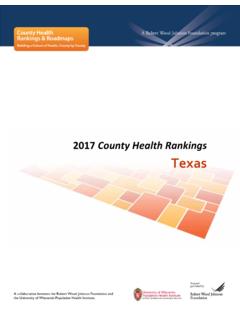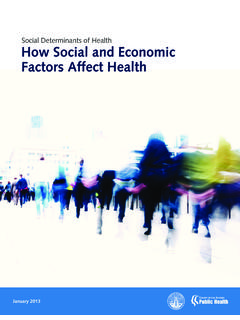Transcription of COUNTY HEALTH RANKINGS WORKING PAPER DIFFERENT ...
1 COUNTY HEALTH RANKINGS WORKING PAPER DIFFERENT PERSPECTIVES FOR assigning WEIGHTS TO DETERMINANTS OF HEALTH Bridget C. Booske Jessica K. Athens David A. Kindig Hyojun Park Patrick L. Remington FEBRUARY 2010 Table of Contents Summary .. 1 Historical perspective .. 2 Review of the Literature .. 4 Weighting Schemes Used by Other RANKINGS .. 5 Analytic Approach .. 6 Pragmatic Approach .. 8 References .. 9 Appendix 1: Weighting in Other RANKINGS .. 11 Appendix 2: Analysis of 2010 COUNTY HEALTH RANKINGS Dataset .. 13 Appendix 3: Results from Kindig et al (in press) .. 17 Appendix 4: Results from World HEALTH Organization.
2 18 1 Summary The COUNTY HEALTH RANKINGS are based on a model of population HEALTH including HEALTH outcomes--based on an equal weighting of length and quality of life, and HEALTH factors--weighted scores of four major factors: HEALTH behaviors, clinical care, social and economic factors, and the physical environment. To calculate the HEALTH factors ranks in the COUNTY HEALTH RANKINGS , each of the four components is weighted based on an assessment of its relative contribution to the HEALTH outcomes described above. Since there is no single correct weighting distribution, we arrived at weights drawing on a number of DIFFERENT perspectives: A.
3 Historical perspective B. Review of the literature C. Weighting schemes used by other HEALTH RANKINGS D. Analytic approach E. Pragmatic (stakeholder engagement) approach The following table summarizes the alternate weighting distributions suggested by these five perspectives and our recommended weighting scheme for the COUNTY HEALTH RANKINGS : Summary of DIFFERENT Perspectives on assigning Weights to Determinants of HEALTH Historical perspective Literature Review Other RANKINGS * Analytic Approach Pragmatic Approach COUNTY HEALTH RANKINGS AHR WI, KS, TN NM Social and economic factors Increasing importance 21% (up to 8x clinical care) 27% 40% 40% 55% 25% 40% HEALTH behaviors 57% 37% 40% 40% 37% 25% 30% Clinical care 14% (up to 50%) 27% 10% 15% 21% 25% 20% Environmental factors 7% 9% 10% 5% -3% 25% 10% *AHR = America s HEALTH RANKINGS .
4 The four other RANKINGS were done within the states of Wisconsin, Kansas, Tennessee, and New Mexico 2 DIFFERENT PERSPECTIVES FOR assigning WEIGHTS TO DETERMINANTS OF HEALTH Historical perspective Over the past century, the leading causes of death and morbidity in the United States have changed dramatically. 1930-1950: Sanitary revolution and improvements in environmental HEALTH In the first half of the 20th century in the , the leading causes of disease and death were associated with the unhealthy environments in which people lived. In 1900, pneumonia, influenza, tuberculosis, diarrhea, enteritis, and ulceration of the intestines accounted for nearly one-third of all deaths.
5 These leading HEALTH problems resulted from poor sanitation ( , typhoid), unhealthy food supply ( , pellagra and goiter), poor prenatal and infant care, and unsafe workplaces or hazardous occupations (CDC 1999b). In response to these HEALTH problems, public HEALTH efforts focused on laws and regulations intended to improve the HEALTH of the environment, such as motor-vehicle safety regulations, occupational safety laws, and control of infectious diseases, safer and healthier foods, and fluoridation of drinking water (CDC 1999a). These policies led to dramatic reductions in communicable diseases and maternal and infant mortality. 1950-1970: Increasing role of HEALTH care By the middle of the 20th century, heart disease and cancer had become the leading causes of death in the United States.
6 The focus of interventions began to shift to HEALTH care services, including the delivery of clinical preventive services such as vaccination for childhood disease, improved maternal and prenatal care, and the detection and treatment of high blood pressure. Despite some attention to preventive services, most of the attention of the HEALTH care system focused on the treatment of diseases. Evans commented that by midcentury the providers of HEALTH care had gained an extraordinary institutional and even more intellectual dominance, defining both what counted as HEALTH and how it was to be pursued. By the early 1970s, the had developed extensive and expensive systems of HEALTH care, underpinned by HEALTH insurance systems that covered most but not all children and adults (Evans and Stoddart 1990).
7 1970-1990: Contribution of HEALTH behaviors (smoking/diet/exercise) increases As heart disease, cancer, stroke, and lung disease became the leading causes of death during the mid-1900s, public HEALTH researchers began to focus on identifying their causes. Large-scale studies such as the Framingham Heart study , the Seven Countries study , and the British Doctors study began to identify the leading causes of chronic diseases. These studies began to elucidate the important contributions of cigarette smoking, diet, physical inactivity, and high blood pressure to the leading causes of death. The Lalonde Report was published in 1974 in Canada and has been recognized as the first modern government report to state that the emphasis on HEALTH care was not sufficient to improve the HEALTH of the population (Lalonde 1974).
8 The report noted that the generally accepted view at that time was that the level of HEALTH in a population was equated with the level of HEALTH care. Instead, it proposed a new HEALTH field concept that HEALTH be broken up into four broad elements: human biology, environment, lifestyle, and HEALTH care organization. The report emphasized individuals' roles in changing their behaviors to improve their HEALTH (Minkler 1989). The publication of the now famous PAPER entitled Actual Causes of Death by McGinnis and Foege (1993) drew attention to the fact that many deaths were due to preventable causes, such as tobacco use, diet and activity patterns, and alcohol use.
9 Later updated by Mokdad (2001), these studies concluded that approximately half of all deaths that occurred in 1990 could be attributed to the factors identified. Although no attempt was made to further quantify the impact of these factors on morbidity and quality of life, the public HEALTH burden they impose is considerable and offers guidance for shaping HEALTH policy priorities. 3 Expert opinion at the time suggested that HEALTH behaviors had the largest and most unambiguously measurable effect on HEALTH . Behaviors such as diet, exercise, substance abuse, were also factors most readily portrayed as under the control of individuals. 1990-present: Social and economic determinants By the beginning of the 21st century, research had begun to focus farther upstream on those factors that increase the risk of not only diseases, but also the predisposing behavioral and other risk factors.
10 According to the Institute of Medicine s report, The Future of the Public s HEALTH in the 21st Century, the greatest advances in understanding the factors that shape population HEALTH over the last two decades has been the identification of social and behavioral conditions that influence morbidity, mortality, and functioning (Institute of Medicine 2002). Research has increasingly demonstrated the important contributions to HEALTH of factors beyond the physical environment, medical care, and HEALTH behaviors, , socioeconomic position, race and ethnicity, social networks and social support, and work conditions, as well as economic inequality and social capital (Institute of Medicine 2002).










